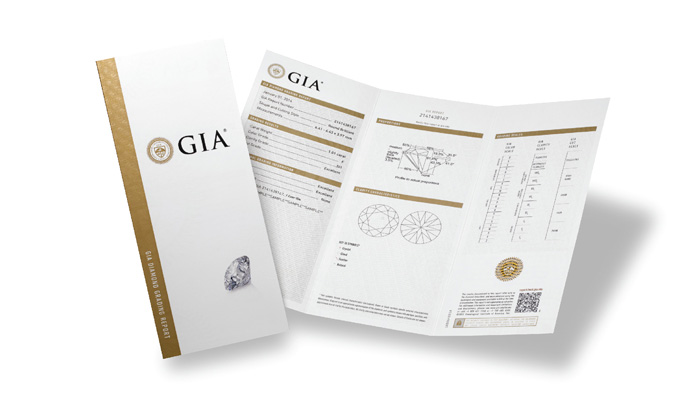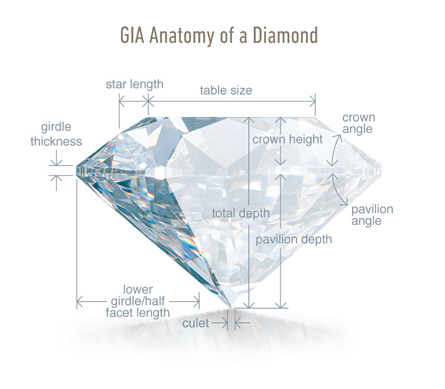What is a GIA certificate? GIA stands for Gemological Institute of America. The GIA created the 4 C’s grading system and also has the strictest grading standards of the leading labs (other labs are IGI, AGS, GSI, EGL) but GIA is also the most consistent. An accredited independent gemological laboratory like the GIA issues a diamond certificate or diamond report. The certificate includes grades for the diamond’s carat, cut, color and clarity. The grades are very subjective since an individual looks at each diamond under a loop (10x magnifying glass) and is the opinion of the individual at the lab. Other information such as the diamond’s polish, symmetry, fluorescence, and a graphical depiction showing the location of the diamond’s inclusions is also included in the certificate.
Once you have the diamond engagement ring GIA certificate/report, first look at the Cut grade. This is the one of the most important pieces of information, as it summarizes the beauty of the stone. GIA certificate grades are based on direct measurements. Beware of other labs that list cut grades based on a model, which is the diamond’s general diagram and general specifications, and not of the actual diamond specs. In addition, check the date it was examined and inspected by the GIA gemologist. If the date is older than 5 years, you can ask for the GIA to inspect the diamond stone again.
Next, look for the Carat weight on the certificate. Don’t confuse “carat weight” with “karat,” which is the method of determining the purity of gold. A diamond’s weight is measured in carats. One carat is equal to 200 milligrams, or 0.2 grams. The weight of smaller diamonds is often expressed as points instead of carats — there are 100 points in a carat. Another way to look at it is to say that each point equals 0.01, or one-hundredth, of a carat. For example, 0.08 means eight one-hundredths, so a 0.08 carat diamond equals eight points. At the top left of the certificate report you will find the dimensions of the diamond. For example, a round diamond might have a measurement of 6.30 x 6.38 x 4.58 mm.
A clarity grade is assigned based on the overall appearance of the stone under 10x magnification glass. Clarity is one of the most important characteristics of a diamond. It is the quality of the diamond as it relates to the existence and visual appearance of internal characteristics called inclusions, and surface defects are called blemishes. Basically there are two types of flaws: inclusions and blemishes. Inclusions refer to internal flaws and blemishes refer to surface flaws. Inclusions include flaws such as air bubbles, cracks, and non-diamond minerals found in the diamond. Blemishes include scratches, pits, and chips. Diamonds with no or few inclusions and blemishes are more valuable than those with less clarity. You will find a diagram at the bottom of the GIA certificate that shows where all the blemishes are located on the diamond face.
The GIA grading system for Clarity:
F - Flawless: No internal or external flaws. Extremely rare.
IF - Internally Flawless: no internal flaws, but some surface flaws. Very rare.
VVS1-VVS2 - Very Very Slightly Included (two grades): Minute inclusions very difficult to detect under 10x magnification by a trained gemologist.
VS1-VS2 - Very Slightly Included (two grades): Minute inclusions seen only with difficulty under 10x magnification.
SI1-SI2 - Slightly Included (two grades): Minute inclusions more easily detected under 10x magnification.
NOTE: For grades F/IF through SI, a diamond’s clarity grade has an impact on the diamond’s value, not on the unmagnified diamond’s appearance.
I1-I2-I3 – Included (three grades): Inclusions visible under 10x magnification AS WELL AS to the human eye.
As for Color, diamonds found in most jewelry run from colorless to near colorless, with slight hints of yellow or brown. Most people find it very difficult (if not impossible) to tell the difference between one color grade to another. The one difference people can see is in the price, which can be significant. GIA’s color-grading scale for diamonds is the industry standard. The scale begins with the letter D, representing colorless, and continues with increasing presence of color to the letter Z, or light yellow or brown. The reason why the GIA color grading starts with the letter ‘D’ because the creators of the GIA Color Scale wanted to start fresh, without any association with earlier systems, they chose to start with the letter D—a letter grade normally not associated with top quality.
At the bottom of the page, you will find a diagram with the dimensions of the diamond stone. It will show the Depth, which represents the total depth of the diamond from table to cutlet as a percentage of the total diameter. The table is the top or width of the diamond. Smaller table percentages are considered better than larger table percentages by some experts. The Culet is the bottom of the diamond that ends in a point. It may be faceted to protect the fragile tip from chipping. The Girdle refers to the thickness of the rim around the diamond and whether it is faceted.
The GIA Diamond Certificate also shows the Polish, Symmetry and Fluorescence of the diamond. No fluorescence is more desirable by experts. Strong fluorescence in slightly yellow diamonds may make them appear whiter, but strong fluorescence in white or fancy colored diamonds is generally less desirable. In addition, if the diamond has a laser inscription then it will have the unique coded number on the certificate.
To find more information of about GIA Certificate/Reports, visit gia.com. If you would like more information about diamond prices, visit www.diamondhedge.com.
Subscribe for free to receive new blog posts.

